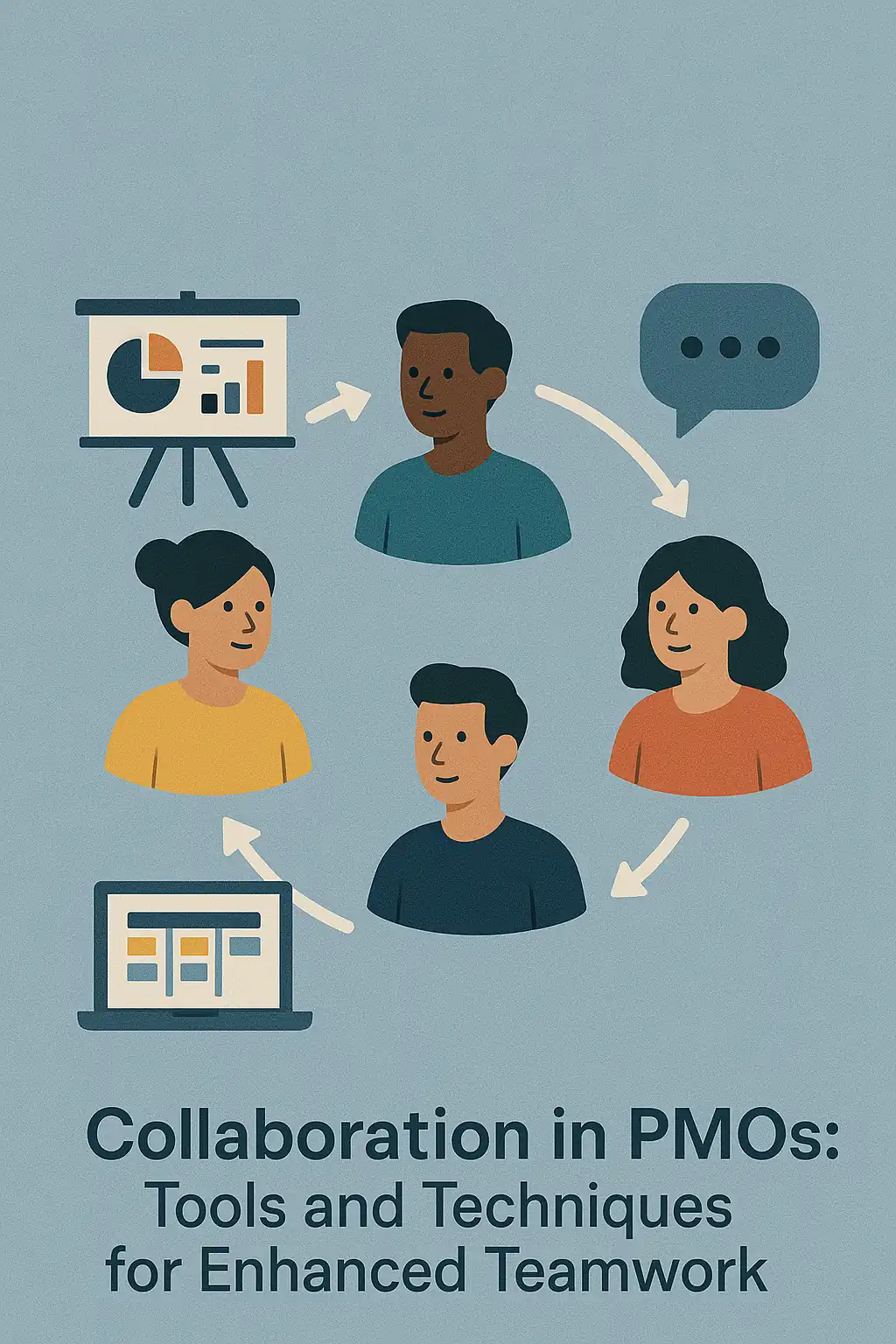Introduction to PMOs and Collaboration
The Project Management Office (PMO) serves as a pivotal entity that standardizes project management practices, facilitates resource sharing, and enhances overall project efficiency. A PMO is essentially an organizational structure designed to provide guidance and support to project teams, ensuring that projects are delivered on time, within budget, and aligned with strategic objectives. The role of a PMO can vary significantly depending on its model, which can influence how effectively it collaborates with project teams.
Overview of Different PMO Models
PMOs can be categorized into several models, each with distinct characteristics and levels of authority:
- Supportive PMO: This model provides a consultative role, offering support and guidance to project teams without exerting direct control. It focuses on sharing best practices, tools, and templates to enhance project execution.
- Controlling PMO: A controlling PMO enforces compliance with project management standards and methodologies. It monitors project performance and may require teams to adhere to specific processes, thereby ensuring consistency across projects.
- Directive PMO: This model takes a more authoritative approach, directly managing projects and resources. A directive PMO has the power to allocate resources and make decisions, which can lead to more streamlined project execution but may limit the autonomy of project teams.
Understanding these models is crucial for PMO managers and project teams, as the chosen model can significantly impact collaboration dynamics and overall project success.
Importance of Collaboration in Enhancing PMO Effectiveness
Collaboration is a cornerstone of effective project management, particularly within PMOs. By fostering open communication and teamwork, PMOs can enhance their performance in several ways:
- Improved Communication: Collaboration tools facilitate real-time communication among team members, reducing misunderstandings and ensuring that everyone is aligned on project goals and progress.
- Increased Productivity: When teams collaborate effectively, they can share knowledge and resources more efficiently, leading to higher productivity and better project outcomes.
- Enhanced Problem-Solving: Collaborative environments encourage diverse perspectives, which can lead to innovative solutions and more effective problem-solving.
- Stronger Relationships: Building a culture of collaboration within a PMO fosters trust and strengthens relationships among team members, which is essential for long-term project success.
The Role of Collaboration Tools in PMOs
Within Project Management Offices (PMOs), collaboration tools play a pivotal role in enhancing teamwork and communication among project teams. These tools are designed to facilitate seamless interaction, streamline processes, and ultimately improve project outcomes.
Definition of Collaboration Tools
Collaboration tools in project management refer to software applications and platforms that enable team members to work together more effectively, regardless of their physical location. These tools support various functions such as communication, file sharing, task management, and project tracking, thereby fostering a collaborative environment that is essential for successful project execution. They are integral to the PMO’s efforts to maintain standards and ensure that projects align with organizational goals [7][4].
Benefits of Using Collaboration Tools
The implementation of collaboration tools within PMOs offers numerous advantages:
- Improved Communication: These tools facilitate real-time communication among team members, reducing misunderstandings and ensuring that everyone is on the same page. This is crucial for distributed teams where face-to-face interactions are limited [1].
- Transparency: Collaboration tools provide visibility into project progress and team activities. This transparency helps stakeholders stay informed and engaged, which is vital for maintaining alignment with project objectives [9].
- Efficiency: By automating routine tasks and providing a centralized platform for information sharing, collaboration tools enhance overall efficiency. Teams can focus on high-priority tasks rather than getting bogged down by administrative work [3].
- Enhanced Coordination: With features that allow for task assignments, deadline tracking, and progress updates, collaboration tools improve coordination among team members, leading to better resource management and project execution [8].
Examples of Popular Collaboration Tools
Several collaboration tools have gained popularity among project teams and PMO managers for their effectiveness in enhancing teamwork:
- Microsoft Teams: This platform integrates chat, video conferencing, and file sharing, making it a comprehensive solution for team collaboration. It allows for easy communication and collaboration on documents in real-time.
- Slack: Known for its user-friendly interface, Slack offers channels for different projects or topics, direct messaging, and integration with various other tools, making it a favorite for many teams looking to streamline communication.
- Asana: Asana is a project management tool that helps teams organize tasks, set deadlines, and track progress. Its collaborative features allow team members to comment on tasks and share updates, fostering a collaborative work environment.
- Trello: Trello uses a card-based system to help teams visualize their projects and tasks. It is particularly useful for managing workflows and ensuring that everyone is aware of their responsibilities and deadlines.
Techniques for Effective Collaboration in PMOs
Collaboration is a cornerstone of successful project management, particularly within Project Management Offices (PMOs). By leveraging the right tools and techniques, PMOs can enhance teamwork, streamline processes, and ultimately improve project outcomes. Here are some actionable techniques and best practices to foster effective collaboration among PMO teams:
- Establishing Clear Communication Channels and Protocols: Effective communication is vital for any PMO. Establishing clear channels—such as dedicated communication platforms (e.g., Slack, Microsoft Teams)—ensures that all team members can easily share information and updates. Additionally, defining communication protocols helps set expectations for response times and the types of information to be shared, which can significantly reduce misunderstandings and enhance team cohesion [1][11].
- Encouraging Regular Updates and Check-Ins Using Collaborative Platforms: Regular updates and check-ins are essential for maintaining alignment within project teams. Utilizing collaborative platforms allows PMOs to schedule recurring meetings and status updates, ensuring that everyone is informed about project progress and any changes that may arise. This practice not only keeps the team engaged but also fosters a culture of accountability and transparency [10][11].
- Implementing Shared Documentation Practices for Transparency and Accessibility: Transparency is crucial in project management. By implementing shared documentation practices—such as using cloud-based tools like Google Drive or SharePoint—PMOs can ensure that all team members have access to the latest project documents, reports, and resources. This accessibility promotes a sense of ownership and encourages team members to contribute actively to project discussions and decisions [1][12].
- Utilizing Project Management Methodologies (e.g., Agile, Scrum) to Facilitate Teamwork: Adopting project management methodologies like Agile or Scrum can significantly enhance collaboration within PMOs. These methodologies emphasize iterative progress, regular feedback, and adaptive planning, which can help teams respond swiftly to changes and challenges. By fostering a collaborative environment where team members can share insights and feedback, PMOs can improve their overall performance and project delivery [1][14].
By implementing these techniques, PMOs can create a more collaborative environment that not only enhances teamwork but also drives better project outcomes. Emphasizing clear communication, regular updates, shared documentation, and effective methodologies will empower PMO teams to work more cohesively and efficiently, ultimately delivering greater value to their organizations.
Impact of Collaboration on PMO Performance
Collaboration within Project Management Offices (PMOs) is increasingly recognized as a critical factor that can significantly enhance overall performance and project success. By leveraging effective collaboration tools and techniques, PMOs can foster a more cohesive working environment that leads to improved outcomes. Here are some key points to consider:
1. Metrics for Assessing PMO Performance
To evaluate the effectiveness of collaboration in PMOs, both quantitative and qualitative metrics can be employed:
- Quantitative Metrics: These include measurable data such as project delivery times, budget adherence, and the number of projects completed on schedule. For instance, a study indicated that organizations with strong collaborative practices often see a reduction in project delivery times by up to 20% due to improved communication and coordination among team members [4][8].
- Qualitative Metrics: These metrics focus on stakeholder satisfaction and team morale. Surveys and feedback mechanisms can be utilized to gauge how team members perceive collaboration efforts and their impact on project outcomes. High levels of stakeholder satisfaction are often linked to effective collaboration, as it ensures that project goals align with stakeholder expectations [4][8].
2. Case Studies Showcasing Successful Collaboration in PMOs
Several organizations have successfully implemented collaboration strategies that have led to notable improvements in PMO performance:
- Case Study 1: A large enterprise adopted a centralized collaboration platform that allowed project teams to share information in real-time. This led to a 30% increase in project completion rates and a significant improvement in team communication, ultimately enhancing project outcomes [3][5].
- Case Study 2: Another organization focused on establishing best practices for collaboration, which included regular team meetings and the use of collaborative tools. As a result, they reported a marked increase in stakeholder satisfaction and a reduction in project costs due to better resource management [5][8].
3. Linking Collaboration to Key PMO Performance Indicators (KPIs)
Collaboration directly influences several key performance indicators (KPIs) that are essential for PMO success:
- Project Delivery Time: Enhanced collaboration can streamline processes and reduce delays. Teams that communicate effectively are more likely to identify potential roadblocks early, allowing for timely interventions [6][7].
- Budget Adherence: When project teams collaborate closely, they can better manage resources and expenses. This proactive approach often results in projects being completed within budget, as teams can quickly address any financial discrepancies [4][6].
- Stakeholder Satisfaction: Effective collaboration ensures that all stakeholders are kept informed and engaged throughout the project lifecycle. This transparency fosters trust and satisfaction, which are crucial for the long-term success of PMOs [4][8].
Challenges to Collaboration in PMOs
Collaboration within Project Management Offices (PMOs) is essential for achieving project success, yet several challenges can hinder effective teamwork. Understanding these barriers is crucial for PMO managers and project teams to implement strategies that enhance collaboration. Here are some common challenges and potential solutions:
Common Challenges
- Resistance to Change: Many team members may be accustomed to traditional ways of working and may resist adopting new collaborative tools and practices. This resistance can stem from a fear of the unknown or a lack of understanding of the benefits of collaboration tools [1].
- Lack of Engagement: Team members may not feel motivated to participate in collaborative efforts, leading to disengagement. This can occur when individuals do not see the value in collaboration or when their contributions are not recognized [2].
- Geographical Barriers: In today’s globalized work environment, teams often consist of members from different locations. This geographical dispersion can create communication challenges and hinder effective collaboration [3].
Strategies to Overcome These Challenges
- Fostering a Collaborative Culture: PMOs should actively promote a culture that values collaboration. This can be achieved by encouraging open communication, recognizing team achievements, and creating an environment where team members feel safe to share ideas and feedback [4].
- Providing Training on Tools: To address resistance to change and improve engagement, PMOs should offer training sessions on the collaborative tools being implemented. This training should focus on demonstrating the tools’ benefits and how they can enhance team performance [5].
- Utilizing Technology: Implementing the right collaboration tools can bridge geographical gaps. Tools that facilitate real-time communication, project tracking, and document sharing can help teams stay connected and work together more effectively, regardless of their physical locations [6].
Importance of Leadership Support
Leadership plays a pivotal role in promoting collaboration within PMOs. When leaders actively support collaborative initiatives, it sets a positive example for team members and reinforces the importance of teamwork. Leaders should:
- Encourage Participation: Actively involve team members in decision-making processes and encourage them to share their insights and ideas [7].
- Provide Resources: Ensure that teams have access to the necessary tools and resources to collaborate effectively. This includes investing in technology and providing ongoing support [8].
- Model Collaborative Behavior: Leaders should demonstrate collaborative behavior themselves, showing how teamwork can lead to better project outcomes. This modeling can inspire team members to engage more fully in collaborative efforts [9].
By addressing these challenges and implementing effective strategies, PMOs can enhance collaboration, leading to improved project performance and successful outcomes.
Future Trends in PMO Collaboration
As project management offices (PMOs) evolve, the integration of advanced technologies and methodologies is becoming increasingly vital for enhancing collaboration among project teams. Here are some key trends that are shaping the future of collaboration in PMOs:
- The Rise of AI and Machine Learning: Artificial intelligence (AI) and machine learning are revolutionizing project management tools by enabling more efficient task allocation, resource management, and progress tracking. These technologies help project managers make data-driven decisions, anticipate potential risks, and automate repetitive tasks, ultimately leading to improved project outcomes and team performance [1][7].
- Increased Focus on Remote and Hybrid Work Collaboration: The shift towards remote and hybrid work models has necessitated the adoption of essential virtual collaboration tools. Platforms like Microsoft Teams, Slack, and Zoom have become integral to project management, allowing teams to communicate effectively despite geographical barriers. This trend is expected to continue, with a growing reliance on these tools to facilitate collaboration among distributed teams [12][13].
- Predictive Analytics for Team Performance and Project Outcomes: Predictive analytics is emerging as a powerful tool for PMOs, providing insights into project performance and helping teams foresee potential issues. By leveraging AI-powered analytics, PMOs can enhance their ability to manage risks proactively, optimize resources, and improve overall project success rates. This data-driven approach is set to become a cornerstone of effective project management in the future [9][14].
- The Role of Social Collaboration Platforms: Social collaboration platforms are increasingly being recognized for their potential to enhance engagement within PMOs. These platforms facilitate informal communication and knowledge sharing among team members, fostering a collaborative culture that can lead to improved project outcomes. By integrating social collaboration tools into their workflows, PMOs can enhance team cohesion and drive better performance [4][10].
Conclusion
In Project Management Offices (PMOs), the integration of collaboration tools and techniques is not just beneficial; it is essential for enhancing overall performance and effectiveness. As we have explored, the adoption of these tools can lead to significant improvements in communication, transparency, and project outcomes. Here are the key takeaways:
- Benefits of Collaboration Tools: Collaboration tools streamline communication among team members, facilitate real-time updates, and foster a culture of transparency. This leads to improved decision-making and a more cohesive team environment, ultimately driving project success. By utilizing platforms that support document sharing, task management, and instant messaging, PMOs can ensure that all stakeholders are aligned and informed throughout the project lifecycle.
- Integration into PMO Workflows: It is crucial for PMOs to not only adopt collaboration tools but also to integrate them into their existing workflows. This means training team members on how to effectively use these tools and encouraging a shift in mindset towards collaborative practices. By embedding collaboration into the daily routines of project teams, PMOs can enhance productivity and engagement, leading to better project outcomes.
- Evaluation of Current Strategies: PMO managers are encouraged to take a proactive approach in evaluating their current collaboration strategies. This involves assessing the effectiveness of existing tools, gathering feedback from team members, and identifying areas for improvement. By regularly reviewing and refining collaboration practices, PMOs can adapt to changing project demands and ensure that they are leveraging the best tools available to support their teams.
In conclusion, the importance of collaboration in PMOs cannot be overstated. By embracing collaboration tools and techniques, PMOs can significantly enhance their performance, foster a more engaged workforce, and ultimately achieve greater project success. It is time for PMO managers to take action, evaluate their strategies, and commit to a collaborative future.
Find out more about Shaun Stoltz https://www.shaunstoltz.com/about/.
This post was written by an AI and reviewed/edited by a human.



